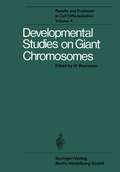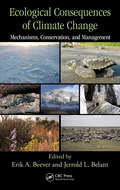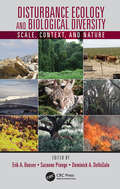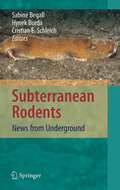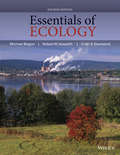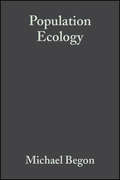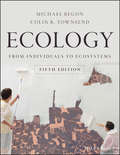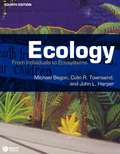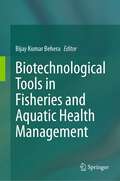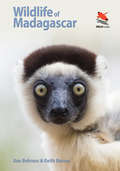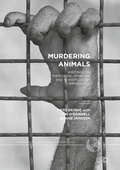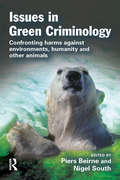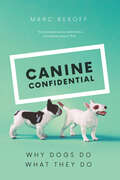- Table View
- List View
Developmental Studies on Giant Chromosomes (Results and Problems in Cell Differentiation #4)
by W. BeermannEarlier titles in this series have directed attention to selected questions of current theoretical or practical interest in developmental biology, without special emphasis upon individual biological systems. Tho choose giant polytene chromosomes as the common denominator of a new volume may at first sight seem to set rather arbitrary restrictions upon a coherent discussion of the basic problem of cellular differentiation. However, the reader will find out for hirnself that, on the contrary, such a limitation, though dicta ted by the material, focuses the analysis upon one essential point: the differential release of genetic information from operational subunits of the eukaryotic chromosome. In the organization of this volume we have not striven for completeness - some, indeed, may fee 1 that the work on Sciarids is underrepresented - but the various contributors have made every effort to render a thorough and up-to-date picture of the situation in their particular field, and on this basis to discuss all possible angles of general biological interest. Authors and editors have agreed to dedicate this volume to the memory of JACK SCHULTZ.
Ecological Consequences of Climate Change: Mechanisms, Conservation, and Management
by Erik A. Beever Jerrold L. BelantContemporary climate change is a crucial management challenge for wildlife scientists, conservation biologists, and ecologists of the 21st century. Climate fingerprints are being detected and documented in the responses of hundreds of wildlife species and numerous ecosystems around the world. To mitigate and accommodate the influences of climate ch
Disturbance Ecology and Biological Diversity: Context, Nature, and Scale
by Erik A. Beever Inger Suzanne Prange Dominick A. DellaSalaThis book presents cascading effects of ecological disturbances on a multitude of ecosystem components. It includes agricultural development, large infrequent disturbances, forest harvesting, non-native grazing in deserts, ground transportation, powerline corridors, fires, urban ecology, disturbance in aquatic ecosystems, land-use dynamics on diversity, habitat fragmentation, sedimentation of wetlands, and contemporary climate change. The book facilitates users in understanding why disturbances are occurring while recommending mitigation and remediation strategies.
Disturbance Ecology and Biological Diversity: Context, Nature, and Scale
by Erik A. Beever Inger Suzanne Prange Dominick A. DellaSalaThis book presents cascading effects of ecological disturbances on a multitude of ecosystem components. It includes agricultural development, large infrequent disturbances, forest harvesting, non-native grazing in deserts, ground transportation, powerline corridors, fires, urban ecology, disturbance in aquatic ecosystems, land-use dynamics on diversity, habitat fragmentation, sedimentation of wetlands, and contemporary climate change. The book facilitates users in understanding why disturbances are occurring while recommending mitigation and remediation strategies.
Subterranean Rodents: News from Underground
by Sabine Begall Hynek Burda Cristian Eric SchleichSubterranean Rodents presents achievements from recent years of research on these rodents, divided into five sections: ecophysiology; sensory ecology; life histories, behavioural ecology and demography; environmental and economical impact; molecular ecology and evolution. It is a must for all researchers working in this field and will be of interest to zoologists, physiologists, morphologists, ecologists, and evolutionary biologists.
New Concepts of a Blood—Brain Barrier
by D. J. Begley J. Greenwood M. SegalThe scientific contribution of Mike Bradbury to the study of the blood-brain barrier is considerable and wide-ranging, starting with his M.D. thesis in 1962 and still continuing today. The varied spectrum of topics relating to the blood-brain barrier presented in this volume and the many geographical locations from which both speakers and participants gathered to attend the symposium are a fitting testament both to Mike's wide-spread influence in the field and to the esteem in which he is held. When we first had the idea of afestschrift to mark Mike's retirement as Professor of Physiology at King's College London and the beginning of a new vie libre as scientist and yachtsman the plan was initially for a gathering of all of the many colleagues, collaborators and students who had worked with him over the years. However what we had not taken into account was the closeness of the international community of workers in the field, the widespread influence that Mike had wielded and the speed with which word would spread. We should have anticipated all three. The final outcome was an excellent symposium with the majority of the world's key workers either contributing or attending. We hope that this volume presents an adequate record of the meeting.
Essentials of Ecology
by Michael Begon Robert W. Howarth Colin R. TownsendEssentials of Ecology, 4th Edition presents introductory ecology in an accessible, state-of-the-art format designed to cultivate the novice student's understanding of, and fascination with, the natural world. This new edition has been updated throughout, with new, full-color illustrations, and comes with an accompanying website with downloadable illustrations, multiple-choice questions, and interactive models.
Population Ecology: A Unified Study of Animals and Plants
by Michael Begon Martin Mortimer David J. ThompsonWorldwide, Population Ecology is the leading textbook on this titled subject. Written primarily for students, it describes the present state of population ecology in terms that can be readily understood by undergraduates with little or no background in the subject. Carefully chosen experimental examples illustrate each topic, and studies of plants and animals are combined to show how fundamental principles can be derived that apply to both species. Use of complex mathematics ia avoided throughout the book, and what math is necessary is dealt with by examination of real experimental data rather than dull theory. The latest edition of this leading textbook. Adopted as an Open University set text.
Ecology: From Individuals to Ecosystems
by Michael Begon Colin R. TownsendA definitive guide to the depth and breadth of the ecological sciences, revised and updated The revised and updated fifth edition of Ecology: From Individuals to Ecosystems – now in full colour – offers students and practitioners a review of the ecological sciences. The previous editions of this book earned the authors the prestigious ‘Exceptional Life-time Achievement Award’ of the British Ecological Society – the aim for the fifth edition is not only to maintain standards but indeed to enhance its coverage of Ecology. In the first edition, 34 years ago, it seemed acceptable for ecologists to hold a comfortable, objective, not to say aloof position, from which the ecological communities around us were simply material for which we sought a scientific understanding. Now, we must accept the immediacy of the many environmental problems that threaten us and the responsibility of ecologists to play their full part in addressing these problems. This fifth edition addresses this challenge, with several chapters devoted entirely to applied topics, and examples of how ecological principles have been applied to problems facing us highlighted throughout the remaining nineteen chapters. Nonetheless, the authors remain wedded to the belief that environmental action can only ever be as sound as the ecological principles on which it is based. Hence, while trying harder than ever to help improve preparedness for addressing the environmental problems of the years ahead, the book remains, in its essence, an exposition of the science of ecology. This new edition incorporates the results from more than a thousand recent studies into a fully up-to-date text. Written for students of ecology, researchers and practitioners, the fifth edition of Ecology: From Individuals to Ecosystems is anessential reference to all aspects of ecology and addresses environmental problems of the future.
Ecology: From Individuals to Ecosystems (Springer-lehrbuch Ser.)
by Michael Begon Colin R. TownsendA definitive guide to the depth and breadth of the ecological sciences, revised and updated The revised and updated fifth edition of Ecology: From Individuals to Ecosystems – now in full colour – offers students and practitioners a review of the ecological sciences. The previous editions of this book earned the authors the prestigious ‘Exceptional Life-time Achievement Award’ of the British Ecological Society – the aim for the fifth edition is not only to maintain standards but indeed to enhance its coverage of Ecology. In the first edition, 34 years ago, it seemed acceptable for ecologists to hold a comfortable, objective, not to say aloof position, from which the ecological communities around us were simply material for which we sought a scientific understanding. Now, we must accept the immediacy of the many environmental problems that threaten us and the responsibility of ecologists to play their full part in addressing these problems. This fifth edition addresses this challenge, with several chapters devoted entirely to applied topics, and examples of how ecological principles have been applied to problems facing us highlighted throughout the remaining nineteen chapters. Nonetheless, the authors remain wedded to the belief that environmental action can only ever be as sound as the ecological principles on which it is based. Hence, while trying harder than ever to help improve preparedness for addressing the environmental problems of the years ahead, the book remains, in its essence, an exposition of the science of ecology. This new edition incorporates the results from more than a thousand recent studies into a fully up-to-date text. Written for students of ecology, researchers and practitioners, the fifth edition of Ecology: From Individuals to Ecosystems is anessential reference to all aspects of ecology and addresses environmental problems of the future.
Ecology: From Individuals to Ecosystems
by Michael Begon Colin R. Townsend John L. HarperBegon, Townsend, and Harper's Ecology has long been regarded as the definitive textbook on all aspects of ecology. This new edition provides a comprehensive treatment of the subject, from the first principles of ecology to the current state of the field, and aims to improve students' preparedness to address the environmental problems of the new millennium. Thoroughly revised and updated, this fourth edition includes: three new chapters on applied ecology, reflecting a rigorous, scientific approach to the ecological problems now facing mankind discussion of over 800 new studies, updating the text throughout an updated, user-friendly design with margin notes and chapter summaries that serve as study aids The resulting textbook is easy to use, lucid and up-to-date, and is the essential reference for all students whose degree program includes ecology and for practicing ecologists.
Oribatid Mites: Biodiversity, Taxonomy and Ecology
by Valerie Behan-Pelletier Zoë LindoOribatid mites, also called beetle or moss mites, include more than 10,000 named species representing 172 families worldwide. This book provides an identification key to the 96 families, 250 genera and the c.580 described species for Canada and Alaska, a fauna that encompasses more than 50% of Northern Hemisphere genera. It includes known data on the ecology of species, their distribution in the Holarctic region, and relevant literature. Oribatid mites are model arthropods in studies on development, morphology, ecology, physiology, and biomechanics. Growing recognition of the importance of soil systems for agriculture, reclamation, carbon storage and climate mitigation has spurred recent interest in the vast soil biodiversity that provide these ecosystem services. Yet the major barrier to exploring and understanding soil biodiversity is lack of comprehensive and functional taxonomic and ecological treatments of key biotic groups; groups such as the oribatid mites. Oribatid Mites is unparalleled in the comprehensive nature of the information provided. The authors, two leading global experts for this group, hope that readers will come to share their understanding of oribatid mites as part of the charismatic microfauna, the imagery in this book conveying their unique beauty.
Oribatid Mites: Biodiversity, Taxonomy and Ecology
by Valerie Behan-Pelletier Zoë LindoOribatid mites, also called beetle or moss mites, include more than 10,000 named species representing 172 families worldwide. This book provides an identification key to the 96 families, 250 genera and the c.580 described species for Canada and Alaska, a fauna that encompasses more than 50% of Northern Hemisphere genera. It includes known data on the ecology of species, their distribution in the Holarctic region, and relevant literature. Oribatid mites are model arthropods in studies on development, morphology, ecology, physiology, and biomechanics. Growing recognition of the importance of soil systems for agriculture, reclamation, carbon storage and climate mitigation has spurred recent interest in the vast soil biodiversity that provide these ecosystem services. Yet the major barrier to exploring and understanding soil biodiversity is lack of comprehensive and functional taxonomic and ecological treatments of key biotic groups; groups such as the oribatid mites. Oribatid Mites is unparalleled in the comprehensive nature of the information provided. The authors, two leading global experts for this group, hope that readers will come to share their understanding of oribatid mites as part of the charismatic microfauna, the imagery in this book conveying their unique beauty.
Biotechnological Tools in Fisheries and Aquatic Health Management
by Bijay Kumar BeheraThis edited book is focused on SDG 14: life below water. This book covers all aspects of fish biotechnology and health management. A detailed description is provided of CRISPR Cas9 technology application in the development of superior variety of fish with better growth, disease resistance, etc., accompanied by numerous helpful photographs and schematic diagrams. In addition, recent developments in nanotechnology and its application in fisheries production enhancement have been discussed. Further, topics includes, probiotics, immunostimulants, fish genetic markers, bioremediation, metagenomics, transgenerational immune priming, application of cell culture in fisheries and nano-biosensor application on fish disease diagnosis, pollution monitoring, etc. are provided in details. . The book is helpful for researchers, teachers, students, farmers, and entrepreneurs in utilizing the knowledge on recent advancements in different aspects of fish genetics and biotechnology for future research and aquaculture production enhancement.
Progress in Botany: Structural Botany Physiology Genetics Taxonomy Geobotany/Fortschritte der Botanik Struktur Physiologie Genetik Systematik Geobotanik (Progress in Botany #50)
by H.-Dietmar Behnke Karl Esser Klaus Kubitzki Michael Runge Hubert ZieglerThe 50th volume of Progress in Botany appears in new guise. In cooperation with Springer-Verlag we have changed from the less attractive typewriter composition to the direct reproduction of a manuscript which was writ ten by means of a text editing system and produced by a laser printer. We, the editors, should like to take the appearance of Volume 50 as the occasion for a few short remarks. Our younger readers are perhaps not aware that our Book Series was founded in 1931 by Fritz von Wettstein, based on the following thoughts and considerations, aptly formulated by him in the Preface to the first volume. "One of the greatest dangers threatening progress in the science of botany is the absolutely unbelievable growth in volume of the literature. The quality of journals, books and individual works that are daily sent to us makes it impossible for anyone person to maintain a general view of the progress made in botany in all the specialized fields, let alone to find time for results from associated su bjects. For varying reasons, every botanist must find this state of matters insupportable. Let us endeavor, in the general interest, to retain a wide background of knowledge, and not become limited specialists. The vitally necessary connections between the specialized fields can only flourish, or even exist, if the general view of botany as a whole can be maintained.
Progress in Botany (Progress in Botany #51)
by H.-Dietmar Behnke Karl Esser Klaus Kubitzki Michael Runge Hubert ZieglerProgress in Botany: Structural Botany Physiology Genetics Taxonomy Geobotany Fortschritte der Botanik Struktur Physiologie Genetik Systematik Geobotanik (Progress in Botany #49)
by H.-Dietmar Behnke Karl Esser Klaus Kubitzki Michael Runge Hubert ZieglerSinnhafte Strukturen des Handelns und neurobiologische Prozesse des Sehens: Zur soziologischen Bestimmung von Wahrnehmen als Handeln sowie zur Kritik der neurowissenschaftlichen Rede über Gehirn, Bewusstsein und visuelle Wahrnehmung (Edition KWV)
by Olaf Behrend„Die Schwierigkeit ist, um darauf nochmals hinzuweisen, einen Gedanken zu denken, der den Funktionen der neuronalen Vorgänge tatsächlich gerecht wird, nämlich dass die neuronale Aktivität der neuronalen Areale unser bewusstes Sehen realisiert bzw. ist, ohne dass das Sehen dort wäre oder wir dort im Kopf etwas sähen oder Neuronen dort etwas repräsentierten. Denn das Sehen ist eine Relation, und das Gesehene ist dort, wo wir es mit den Augen sehen.“Die 2008 erstmals erschienene Studie gibt sowohl einen grundsätzlichen Einblick in die neurophysiologischen Grundlagen des Sehens als auch und vor allem eine differenzierte Diskussion und Kritik neurowissenschaftlicher bzw. -psychologischer Theorien der visuellen Wahrnehmung. Es werden deren philosophische Wurzeln und mit diesen verbundene Probleme und mereologische Fehler aufgezeigt. Schließlich werden Grundlagen zu einer handlungsorientierten Auffassung der visuellen Wahrnehmung (unter Berücksichtigung emotionaler Bewertungen) dargelegt. Die in Grundzügen entwickelte Position weist Parallelen zu John R. Searles („Seeing things as they are“) entwickelten Wahrnehmungstheorie auf, was den grundsätzlichen Charakter der Studie zum Ausdruck bringt und ihre Wiederauflage rechtfertigt.
Wildlife of Madagascar
by Ken Behrens Keith BarnesThe Indian Ocean island of Madagascar is one of the world's great natural treasures and ecotourism destinations. Despite being an island, it is home to nearly an entire continent’s variety of species, from the famous lemurs to a profusion of bizarre and beautiful birds, reptiles and amphibians. Wildlife of Madagascar is a compact and beautifully illustrated photographic guide, and an essential companion for any visitor or resident. With an eye-catching design, authoritative and accessible text and easy-to-use format, it provides information on identification, distribution, habitat, behaviour, biology and conservation for all the mammals, birds, reptiles, amphibians and butterflies likely to be seen. The most comprehensive single-volume field guide to Madagascar’s wildlife Attractive layout features more than 900 stunning colour photographs Covers the mammals, birds, reptiles, amphibians and butterflies, and some of the other invertebrates and plants, most likely to be seen Provides key information about identification, distribution, habitat, behaviour and conservation Introductory sections provide background information on Madagascar and its unique environments
Murdering Animals: Writings on Theriocide, Homicide and Nonspeciesist Criminology (Palgrave Studies in Green Criminology)
by Piers BeirneMurdering Animals confronts the speciesism underlying the disparate social censures of homicide and “theriocide” (the killing of animals by humans), and as such, is a plea to take animal rights seriously. Its substantive topics include the criminal prosecution and execution of justiciable animals in early modern Europe; images of hunters put on trial by their prey in the upside-down world of the Dutch Golden Age; the artist William Hogarth’s patriotic depictions of animals in 18th Century London; and the playwright J.M. Synge’s representation of parricide in fin de siècle Ireland. Combining insights from intellectual history, the history of the fine and performing arts, and what is known about today’s invisibilised sites of animal killing, Murdering Animals inevitably asks: should theriocide be considered murder? With its strong multi- and interdisciplinary approach, this work of collaboration will appeal to scholars of social and species justice in animal studies, criminology, sociology and law.
Issues in Green Criminology
by Piers Beirne Nigel SouthIssues in Green Criminology: confronting harms against environments, humanity and other animals aims to provide, if not a manifesto, then at least a significant resource for thinking about green criminology, a rapidly developing field. It offers a set of specially written introductions and a variety of current and new directions, wide-ranging in scope and international in terms of coverage and contributors. It provides focused discussions of current and cutting edge issues that will influence the emergence of a coherent perspective on green issues. The contributors are drawn from the leading thinkers in the field. The twelve chapters of the book explore the myriad ways in which governments, transnational corporations, military apparatuses and ordinary people going about their everyday lives routinely harm environments, other animals and humanity. The book will be essential reading not only for students taking courses in colleges and universities but also for activists in the environmental and animal rights movements. Its concern is with an ever-expanding agenda − the whys, the hows and the whens of the generation and control of the many aspects of harm to environments, ecological systems and all species of animals, including humans. These harms include, but are not limited to, exploitation, modes of discrimination and disempowerment, degradation, abuse, exclusion, pain, injury, loss and suffering. Straddling and intersecting these many forms of harm are key concepts for a green criminology such as gender inequalities, racism, dominionism and speciesism, classism, the north/south divide, the accountability of science, and the ethics of global capitalist expansion. Green criminology has the potential to provide not only a different way of examining and making sense of various forms of crime and control responses (some well known, others less so) but can also make explicable much wider connections that are not generally well understood. As all societies face up to the need to confront harms against environments, other animals and humanity, criminology will have a major role to play. This book will be an essential part of this process.
Thermodynamic Optimization of Complex Energy Systems (NATO Science Partnership Subseries: 3 #69)
by Adrian Bejan Eden MamutA comprehensive assessment of the methodologies of thermodynamic optimization, exergy analysis and thermoeconomics, and their application to the design of efficient and environmentally sound energy systems. The chapters are organized in a sequence that begins with pure thermodynamics and progresses towards the blending of thermodynamics with other disciplines, such as heat transfer and cost accounting. Three methods of analysis stand out: entropy generation minimization, exergy (or availability) analysis, and thermoeconomics. The book reviews current directions in a field that is both extremely important and intellectually alive. Additionally, new directions for research on thermodynamics and optimization are revealed.
Canine Confidential: Why Dogs Do What They Do
by Marc BekoffFor all the love and attention we give dogs, much of what they do remains mysterious. Just think about different behaviors you see at a dog park: We have a good understanding of what it means when dogs wag their tails—but what about when they sniff and roll on a stinky spot? Why do they play tug-of-war with one dog, while showing their bellies to another? Why are some dogs shy, while others are bold? What goes on in dogs’ heads and hearts—and how much can we know and understand? Canine Confidential has the answers. Written by award-winning scientist—and lifelong dog lover—Marc Bekoff, it not only brilliantly opens up the world of dog behavior, but also helps us understand how we can make our dogs’ lives the best they can possibly be. Rooted in the most up-to-date science on cognition and emotion—fields that have exploded in recent years—Canine Confidential is a wonderfully accessible treasure trove of new information and myth-busting. Peeing, we learn, isn’t always marking; grass-eating isn’t always an attempt to trigger vomiting; it’s okay to hug a dog—on their terms; and so much more. There’s still much we don’t know, but at the core of the book is the certainty that dogs do have deep emotional lives, and that as their companions we must try to make those lives as rich and fulfilling as possible. It’s also clear that we must look at dogs as unique individuals and refrain from talking about “the dog.” Bekoff also considers the practical importance of knowing details about dog behavior. He advocates strongly for positive training—there’s no need to dominate or shame dogs or to make them live in fear—and the detailed information contained in Canine Confidential has a good deal of significance for dog trainers and teachers. He also suggests that trainers should watch and study dogs in various contexts outside of those in which they are dealing with clients, canine and human, with specific needs. There’s nothing in the world as heartwarming as being greeted by your dog at the end of the workday. Read Canine Confidential, and you’ll be on the road to making your shared lives as happy, healthy, and rewarding as they can possibly be.
Canine Confidential: Why Dogs Do What They Do
by Marc BekoffFor all the love and attention we give dogs, much of what they do remains mysterious. Just think about different behaviors you see at a dog park: We have a good understanding of what it means when dogs wag their tails—but what about when they sniff and roll on a stinky spot? Why do they play tug-of-war with one dog, while showing their bellies to another? Why are some dogs shy, while others are bold? What goes on in dogs’ heads and hearts—and how much can we know and understand? Canine Confidential has the answers. Written by award-winning scientist—and lifelong dog lover—Marc Bekoff, it not only brilliantly opens up the world of dog behavior, but also helps us understand how we can make our dogs’ lives the best they can possibly be. Rooted in the most up-to-date science on cognition and emotion—fields that have exploded in recent years—Canine Confidential is a wonderfully accessible treasure trove of new information and myth-busting. Peeing, we learn, isn’t always marking; grass-eating isn’t always an attempt to trigger vomiting; it’s okay to hug a dog—on their terms; and so much more. There’s still much we don’t know, but at the core of the book is the certainty that dogs do have deep emotional lives, and that as their companions we must try to make those lives as rich and fulfilling as possible. It’s also clear that we must look at dogs as unique individuals and refrain from talking about “the dog.” Bekoff also considers the practical importance of knowing details about dog behavior. He advocates strongly for positive training—there’s no need to dominate or shame dogs or to make them live in fear—and the detailed information contained in Canine Confidential has a good deal of significance for dog trainers and teachers. He also suggests that trainers should watch and study dogs in various contexts outside of those in which they are dealing with clients, canine and human, with specific needs. There’s nothing in the world as heartwarming as being greeted by your dog at the end of the workday. Read Canine Confidential, and you’ll be on the road to making your shared lives as happy, healthy, and rewarding as they can possibly be.
Canine Confidential: Why Dogs Do What They Do
by Marc BekoffFor all the love and attention we give dogs, much of what they do remains mysterious. Just think about different behaviors you see at a dog park: We have a good understanding of what it means when dogs wag their tails—but what about when they sniff and roll on a stinky spot? Why do they play tug-of-war with one dog, while showing their bellies to another? Why are some dogs shy, while others are bold? What goes on in dogs’ heads and hearts—and how much can we know and understand? Canine Confidential has the answers. Written by award-winning scientist—and lifelong dog lover—Marc Bekoff, it not only brilliantly opens up the world of dog behavior, but also helps us understand how we can make our dogs’ lives the best they can possibly be. Rooted in the most up-to-date science on cognition and emotion—fields that have exploded in recent years—Canine Confidential is a wonderfully accessible treasure trove of new information and myth-busting. Peeing, we learn, isn’t always marking; grass-eating isn’t always an attempt to trigger vomiting; it’s okay to hug a dog—on their terms; and so much more. There’s still much we don’t know, but at the core of the book is the certainty that dogs do have deep emotional lives, and that as their companions we must try to make those lives as rich and fulfilling as possible. It’s also clear that we must look at dogs as unique individuals and refrain from talking about “the dog.” Bekoff also considers the practical importance of knowing details about dog behavior. He advocates strongly for positive training—there’s no need to dominate or shame dogs or to make them live in fear—and the detailed information contained in Canine Confidential has a good deal of significance for dog trainers and teachers. He also suggests that trainers should watch and study dogs in various contexts outside of those in which they are dealing with clients, canine and human, with specific needs. There’s nothing in the world as heartwarming as being greeted by your dog at the end of the workday. Read Canine Confidential, and you’ll be on the road to making your shared lives as happy, healthy, and rewarding as they can possibly be.
